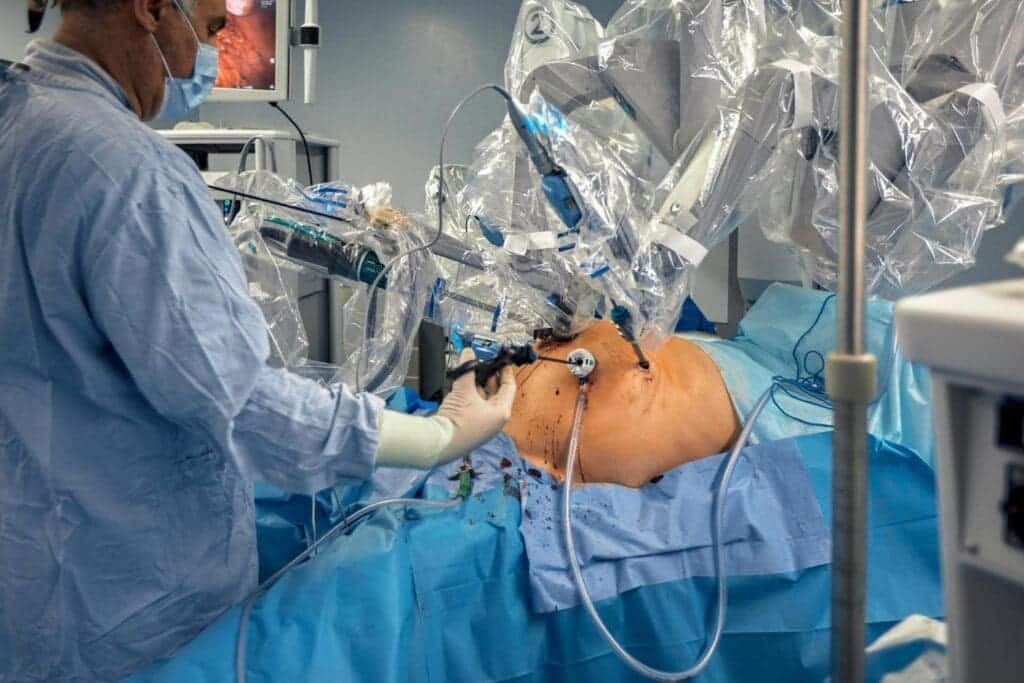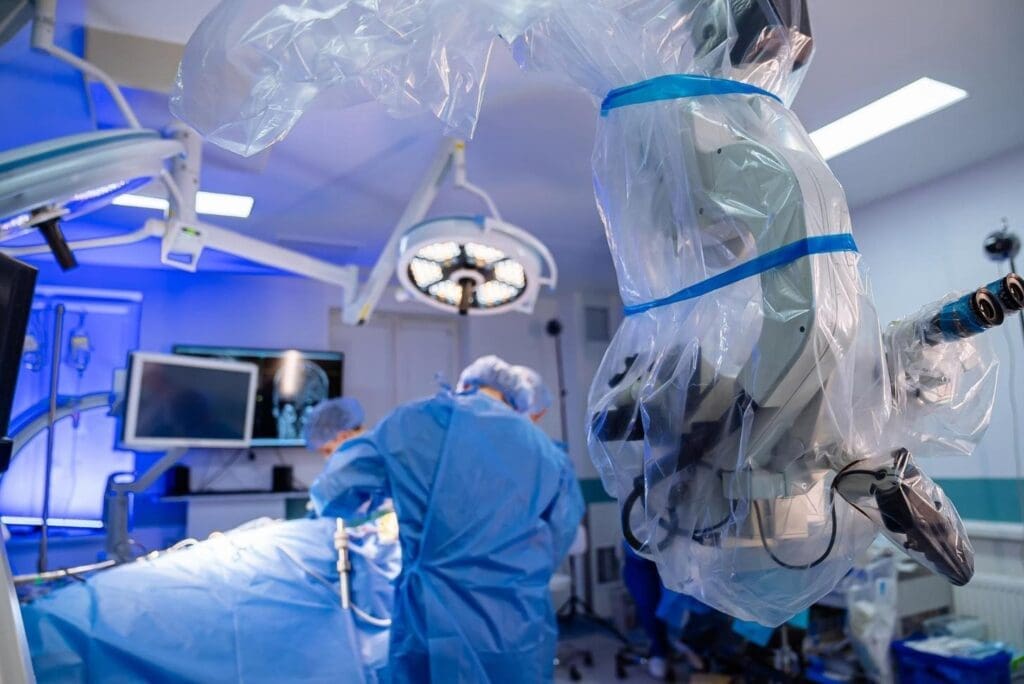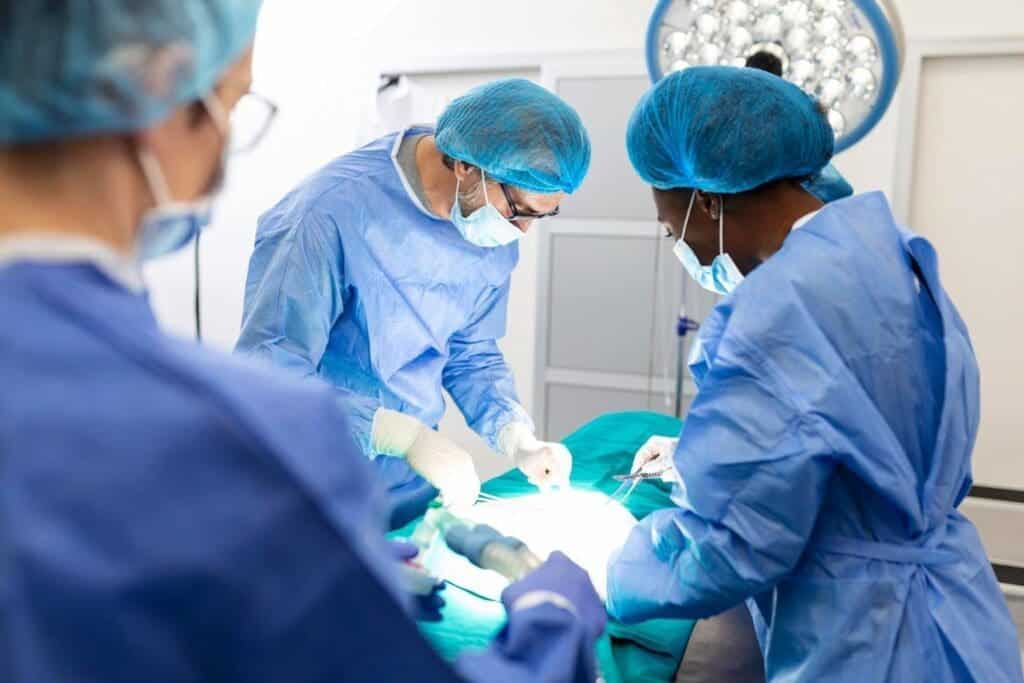Last Updated on November 27, 2025 by Bilal Hasdemir

When looking at minimally invasive surgical options, patients often compare laparoscopic and robotic surgery. At Liv Hospital, we help you understand these advanced techniques. We want you to make a choice that fits your needs.
Both laparoscopic and robotic surgeries use small cuts. But they are different in technology and how they work. Laparoscopic surgery uses a thin tube with a camera and light. Robotic surgery uses robotic arms controlled by a surgeon, giving better precision and a 3D view.
It’s important to know the differences between these two methods. They affect how long the surgery takes, how many complications there are, and how fast you recover. Studies have shown different results, helping patients and surgeons pick the best method for each case.

Minimally invasive surgery has changed the medical world. It offers patients gentler options than old-school open surgery. This change is thanks to new tech and a desire for less invasive methods.
The move from open to minimally invasive surgery has been slow but steady. Laparoscopic surgery, an early minimally invasive method, is now common. It has improved a lot, making it a good choice for many surgeries.
Robotic-assisted surgery has also made a big difference. It brings better precision and control. This makes complex surgeries easier for surgeons.
Today, less invasive surgery is key in healthcare. Patients want quick recovery and less pain. These methods are making care better and outcomes better too.
Minimally invasive surgery has changed how we operate today. Many surgeries are now done laparoscopically or with robots. This change has made care better and changed how surgeons train and use tools.
We’re expecting more tech advancements in surgery. New tools and methods will keep improving minimally invasive surgery. They will shape the future of surgery.

Laparoscopic surgery, also known as keyhole surgery, is a less invasive option compared to open surgery. It involves small incisions for a laparoscope and surgical tools. The laparoscope, with a high-definition camera, shows images on a monitor, helping the surgeon see inside the body clearly.
Laparoscopic surgery aims to reduce body trauma by making smaller incisions. It uses special tools and a laparoscope. The technology has improved a lot, with better imaging and tool design.
Carbon dioxide insufflation is key for clear views during surgery. It fills the abdominal cavity with gas for a clear space.
In traditional laparoscopy, surgeons use instruments while watching the area on a monitor. The laparoscope shows images, either two-dimensional or three-dimensional. The surgeon must make precise movements, as the instruments are limited by fixed ports.
Laparoscopic surgery is used for many procedures, like gallbladder removal and hernia repair. It’s versatile and used in many surgical areas.
Laparoscopic surgery has many benefits, like less pain, shorter hospital stays, and less scarring. But, it requires special training and equipment. It also has some complications.
“Laparoscopic surgery is often chosen for its minimally invasive nature and quicker recovery times.”
— Expert in Minimally Invasive Surgery
While laparoscopic surgery has many benefits, it also has challenges. The technical skills needed and the technique’s limitations are important for surgeons and healthcare providers.
Robotic surgery systems have changed surgery with their precision and flexibility. They let surgeons do complex procedures with better accuracy and less invasion.
Robotic surgery uses advanced robotic arms controlled by surgeons. This tech offers enhanced dexterity and precision. It allows for detailed movements that are hard with traditional tools.
A study in a top medical journal says robotic surgery has greatly improved complex procedure outcomes.
“Robotic-assisted surgery has the power to cut down recovery times and lessen post-operative pain.”
The da Vinci Surgical System is a leading robotic surgical system. It’s known for its 3D visualization and articulated instruments that mimic the human wrist.
Surgeons control robotic equipment from a console. They use controls that turn their hand movements into precise robotic arm actions. This setup offers intuitive control and enhanced visualization of the surgical area.
Robotic surgery is used in many fields, like urology, gynecology, and cardiothoracic surgery. It’s great for tasks needing delicate dissection and precise suturing.
We see robotic surgery changing surgery for the better. As it keeps improving, we expect even more advancements in robotic-assisted surgery.
It’s important to know how control and visualization work in laparoscopic and robotic surgery. These two methods are different in how they help surgeons work inside the body. Each method has its own benefits for the patient.
In laparoscopic surgery, surgeons move their hands to control instruments inside the body. They hold the instruments directly. Robotic surgery, on the other hand, uses a console. Here, surgeons use hand and foot controls to move instruments.
Key differences in control include:
“The robotic system’s ability to scale down the surgeon’s movements allows for more precise dissection and suturing, even in tight spaces.” – A renowned robotic surgeon.
Laparoscopic surgery usually uses 2D images, but some newer systems have 3D. Robotic surgery, by contrast, often uses high-definition 3D images. This makes a big difference in how surgeons see the area they’re working on.
| Visualization Aspect | Laparoscopic Surgery | Robotic Surgery |
| Dimensionality | Primarily 2D, some 3D systems | High-definition 3D |
| Depth Perception | Limited by 2D visualization | Enhanced with 3D visualization |
Robotic surgery often has better magnification and image quality than traditional laparoscopy. The high-definition cameras in robotic systems give a clear, detailed view of the surgical area. This is very helpful in precise procedures.
The control and visualization differences between laparoscopic and robotic surgery affect the surgery’s success. Knowing these differences helps surgeons and patients choose the best option for their needs.
In minimally invasive surgery, how well instruments move is key. This is true for both laparoscopic and robotic methods. The precision and flexibility of these tools are essential for working in tight spaces and doing detailed work.
Laparoscopic tools can move in about 4-5 ways, making it hard to get around inside the body. Robotic tools, on the other hand, can move in up to 7 ways. This gives them more flexibility and accuracy.
Comparison of Degrees of Freedom:
| Surgical Approach | Degrees of Freedom |
| Laparoscopic Surgery | 4-5 |
| Robotic Surgery | Up to 7 |
Robotic surgery has a big plus: its tools move like a wrist. This makes it easier for surgeons to do complex tasks with more precision.
Robotic tools can move and bend in ways laparoscopic tools can’t. This is a big help in delicate surgeries.
Robotic systems are great at reaching hard-to-get places in the body. Their better dexterity and range of motion help surgeons feel more confident.
Robotic surgery has special features like tremor filtration and motion scaling. These help make the surgery more precise. Tremor filtration gets rid of the surgeon’s hand tremors. Motion scaling lets the surgeon make big movements outside the body that turn into small, precise ones inside.
Studies show robotic tools are more dexterous and have a better range of motion than traditional laparoscopic tools. This is very important in complex surgeries where being precise is everything.
We understand how important the dexterity and range of motion of surgical tools are. As technology keeps improving, the benefits of robotic surgery in these areas are becoming clearer.
Exploring laparoscopic and robotic surgeries, we see the role of surgeon experience and design matters. The success of these surgeries isn’t just about the tech. It also depends on the surgeon’s skill and comfort with the tools.
Training for laparoscopic and robotic surgeries is different. Laparoscopic surgery needs great hand-eye coordination and working in a 2D space. Robotic surgery, though, requires knowing how to use a console and understand robotic tools.
Robotic surgery training is more structured. It includes simulation and guidance from experts. This helps surgeons learn the complex skills needed for robotic surgery.
The learning curve for robotic surgery is shorter, thanks to its intuitive controls and better visuals. This makes it easier for surgeons who already know laparoscopy.
Laparoscopic surgery can be tough, with surgeons standing for long times and working in odd positions. Robotic surgery, though, lets surgeons sit, easing physical strain and making long procedures more comfortable.
Ergonomic design in robotic systems helps reduce surgeon fatigue and boosts performance. It lets surgeons work in a more natural way, improving precision and control.
The ergonomic benefits of robotic surgery are clear in long procedures. It reduces physical strain and keeps surgeons comfortable. This helps them stay focused and perform well throughout the surgery.
We understand that surgeon experience and design are key in using laparoscopic and robotic surgeries. Knowing these factors helps us see the benefits and challenges of each method.
When looking at surgery options, it’s key to know about laparoscopic and robotic surgery outcomes. These methods have changed surgery, giving patients less invasive choices than open surgery.
Research shows laparoscopic and robotic surgeries have similar complication rates. Robotic surgery might have a slight edge in avoiding open surgery. Both are safe, with serious issues being rare.
The skill level of surgeons is important. Robotic surgery needs more training. But, once learned, both are very safe.
Both laparoscopic and robotic surgeries cause less blood loss and tissue damage than open surgery. Robotic surgery’s better view and precision might help even more in delicate cases.
Recovery times for laparoscopic and robotic surgeries are shorter than open surgery. Patients often feel less pain because of smaller cuts and less damage. But, recovery can differ based on the surgery, patient health, and surgeon skill.
Cosmetic results are also important. Both methods leave smaller scars than open surgery. Robotic surgery’s precision might lead to even less scarring.
In summary, laparoscopic and robotic surgeries have many benefits for patients. Knowing these points helps patients and doctors choose the best surgery.
Understanding the costs of laparoscopic and robotic surgeries is key for healthcare providers and patients. It’s important to look at the financial side of modern surgery. This helps in making decisions in the operating room.
The cost of starting up with laparoscopic and robotic systems is different. Robotic systems are more expensive because of their advanced technology. They also need ongoing maintenance, like replacing instruments and updating software.
Maintenance costs for robotic systems can be high. This includes service contracts for repairs and technical support. Laparoscopic equipment, while needing maintenance, is cheaper. This is because it’s more common in operating rooms and has more compatible instruments.
Operative time is a big factor in the cost of surgeries. Robotic surgeries usually take longer than laparoscopic ones. This is because of setup time and learning the technology.
But, as surgeons get better at using robots, the time difference gets smaller. Studies show that with more experience, the time it takes for robotic surgeries gets closer to laparoscopic ones. This could make up for some of the initial cost of robots.
The length of hospital stay affects the total cost of care. Both laparoscopic and robotic surgeries reduce hospital stays compared to open surgery. But, the difference between the two is not clear-cut.
Insurance and patient finances are key in choosing between laparoscopic and robotic surgery. Many insurance plans cover both procedures. But, the coverage can vary, and patients may pay different amounts out of pocket.
We must remember that patients’ financial burdens can differ a lot. This depends on their insurance and the costs of their care. It includes the surgery itself and follow-up care.
Understanding the differences between laparoscopic and robotic surgery is key. It helps patients make the right choice for their surgery. By looking at the good and bad of each, patients can pick the best option for them.
Laparoscopic surgery is known for being cost-effective and widely used. Robotic surgery, though, offers better views, precision, and control. This might lead to better results in complex cases. When deciding between laparoscopic vs robotic surgery, patients should talk about their condition, the surgeon’s skills, and the risks and benefits of each.
The choice between laparoscopic and robotic surgery depends on many things. These include the patient’s health, the surgeon’s experience, and the hospital’s resources. By thinking about these factors and knowing the main differences, patients can make choices that fit their needs and improve their surgery results.
Laparoscopic surgery uses small incisions and manual tools. Robotic surgery uses a robotic system controlled by the surgeon. This offers better precision and control.
Yes, both are minimally invasive. They use smaller incisions than open surgery. This leads to less damage and quicker healing.
Robotic surgery has better 3D vision and more precise tools. It also filters out tremors. This makes complex surgeries more precise.
Robotic surgery has better vision and tool control. It also makes surgery more comfortable for the surgeon. This can mean less blood loss, less pain, and shorter stays in the hospital.
Yes, robotic surgery costs more due to the robotic systems. But, the cost difference depends on many factors like surgery time and hospital stay.
No, surgeons need special training and certification. They must learn how to use the robotic systems to become skilled.
Both offer quick recovery times compared to open surgery. Robotic surgery might be slightly quicker due to its precision and less tissue damage.
Yes, complex procedures like some urological and gynecological surgeries are better for robotic surgery. They need precise dissection and suturing.
Both reduce post-operative pain more than open surgery. Robotic surgery might reduce pain even more due to its precision and less tissue damage.
Patients should think about the procedure type, surgeon’s skill, benefits and risks, recovery time, and cost. Talking to a healthcare provider is key to choosing the right surgery.
References:
• Zia, R., & Dyer, K. (2023). Laparoscopic versus robotic abdominal and pelvic surgery. Retrieved from https://pmc.ncbi.nlm.nih.gov/articles/PMC10462573/
• Martin, A. C., & Ayyub, B. (2023). Comparative safety of robotic-assisted vs laparoscopic cholecystectomy. JAMA Surgery. Retrieved from https://jamanetwork.com/journals/jamasurgery/fullarticle/2809849
• Privatesurgeonmiltonkeynes. (n.d.). Laparoscopic vs. Robotic Surgery: What’s the difference? Retrieved from https://www.privatesurgeonmiltonkeynes.com/what-is-the-difference-between-laparoscopic-and-robotic-surgery/
• American Medical Association. (2023). Is Robotic-Assisted Surgery Better? Retrieved from https://journalofethics.ama-assn.org/article/robotic-assisted-surgery-better/2023-08
Subscribe to our e-newsletter to stay informed about the latest innovations in the world of health and exclusive offers!